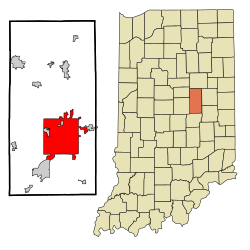Anderson, IN
| Anderson, Indiana | |
|---|---|
| City | |
| City of Anderson | |

Downtown Anderson
|
|
| Motto: Performance. Talent. Inspiration. | |
 Location in the state of Indiana |
|
| Coordinates: 40°6′0″N 85°40′53″W / 40.10000°N 85.68139°WCoordinates: 40°6′0″N 85°40′53″W / 40.10000°N 85.68139°W | |
| Country | United States |
| State | Indiana |
| County | Madison |
| Townships |
Anderson (Primarily) |
| Government | |
| • Mayor | Thomas Broderick, Jr. (D) |
| Area | |
| • Total | 41.48 sq mi (107.43 km2) |
| • Land | 41.37 sq mi (107.15 km2) |
| • Water | 0.11 sq mi (0.28 km2) |
| Elevation | 879 ft (268 m) |
| Population (2010) | |
| • Total | 56,129 |
| • Estimate (2014) | 55,554 |
| • Density | 1,356.8/sq mi (523.9/km2) |
| Time zone | EST (UTC−5) |
| • Summer (DST) | EDT (UTC−4) |
| ZIP codes | 46011-46018 |
| Area code | 765 |
| FIPS code | 18-01468 |
| GNIS ID | 430152 |
| Website | www.cityofanderson.com |
Anderson (Primarily)
Anderson is a city in and the county seat of Madison County, Indiana, United States. It is the principal city of the Anderson, Indiana Metropolitan Statistical Area which encompasses Madison County. Anderson is the headquarters of the Church of God (Anderson) and home of Anderson University, which is affiliated with that denomination. Highlights of the city include the historic Paramount Theatre and the Gruenewald Historic House.
The population was 56,129 at the 2010 census. This is down from 70,000 in 1970.
Prior to the organization of Madison County, William Conner entered the land upon which Anderson is located. Conner later sold the ground to John and Sarah Berry, who donated 32 acres (129,000 m²) of their land to Madison County on the condition that the county seat be moved from Pendleton to Anderson. John Berry laid out the first plat of Anderson on November 7, 1827. In 1828 the seat of justice was moved from Pendleton to Anderson.
The city is named for Chief William "Adam" Anderson, whose mother was a Delaware Indian and whose father was of Swedish descent. Chief Anderson's Indian name was Kikthawenund meaning "creaking boughs". The Delaware village was known as Anderson's Town, though the Moravian Missionaries called it "The Heathen Town Four Miles Away." Anderson was also known as Andersonton before being formally organized as Anderson.
Introduction of internal improvements by the Mammoth Internal Improvement Act caused a growth in the population in 1837. In December, 1838, Anderson was incorporated as a town with 350 inhabitants. The Central Canal, a branch of the Wabash and Erie Canal, was planned to come through Anderson. Work continued on the canal during 1838 and the beginning of 1839, but work on the canal was soon suspended by the state following the Panic of 1837. The town again became a sleepy village until 1849 when it was incorporated a second time as a town. Many new commercial ventures located around the Courthouse Square.
...
Wikipedia
